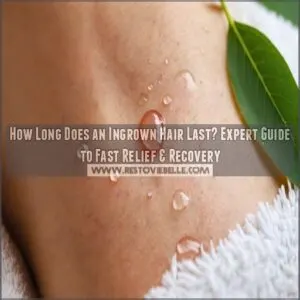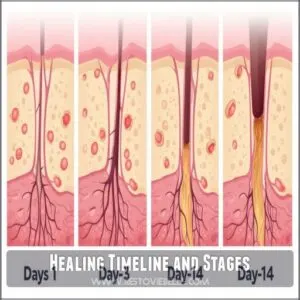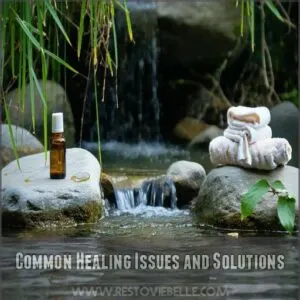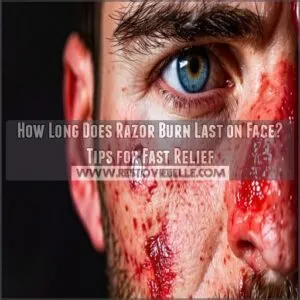This site is supported by our readers. We may earn a commission, at no cost to you, if you purchase through links.
 You’ll be glad to know that an ingrown hair typically lasts between a few days to a week.
You’ll be glad to know that an ingrown hair typically lasts between a few days to a week.
Like an unwanted houseguest, these pesky bumps usually show themselves out on their own as the hair naturally grows and breaks free from the skin.
Your healing time can vary based on factors like the affected area, your skin type, and how you care for it.
While most ingrown hairs are more annoying than serious, keeping the area clean and avoiding the urge to pick can speed up recovery.
There’s more to the story regarding preventing these stubborn strands from making repeat appearances.
Table Of Contents
- Key Takeaways
- Ingrown Hair Overview
- How Long Ingrown Hair Lasts
- Ingrown Hair Healing Process
- Identifying Ingrown Hair Symptoms
- Complications of Untreated Ingrown Hairs
- Preventing Ingrown Hairs and Promoting Healing
- Frequently Asked Questions (FAQs)
- How long do ingrown hairs last?
- Will an ingrown toenail clear up on its own?
- How long does it take for ingrown hair to heal?
- How long does ingrown hair last on a beard?
- What happens if ingrown hair is left untreated?
- Can infected ingrown hairs clear up without treatment?
- How do you treat infected ingrown hair?
- What happens if an infected ingrown hair goes untreated?
- Should I squeeze an infected ingrown hair?
- What does an infected ingrown hair cyst look like?
- Conclusion
Key Takeaways
- You can expect most ingrown hairs to heal naturally within a week or two, but infected or stubborn ones may take longer to resolve.
- Keep the area clean, exfoliate gently, and avoid picking to speed up recovery and reduce the risk of infection or scarring.
- Using proper hair removal techniques and maintaining good skincare habits, like moisturizing and exfoliating, can prevent future ingrown hairs.
- If an ingrown hair becomes infected or doesn’t improve, it’s best to consult a doctor to avoid complications like scarring or prolonged irritation.
Ingrown Hair Overview
You’ll find those pesky ingrown hairs when your hair grows sideways or back into the skin instead of up through the surface, often showing up as red, irritated bumps in areas where you shave or wax.
While most ingrown hairs heal within 1-2 weeks on their own, factors like your hair type, removal method, and skin care routine can affect how quickly they clear up.
Definition and Causes
Getting stuck with an ingrown hair happens when your hair decides to grow sideways or curl back into your skin instead of breaking through the surface. Your hair follicle structure and genetic factors play a key role in this frustrating situation.
- Coarse or curly hair texture increases your chances of developing ingrown hairs
- Improper hair removal methods can trigger these pesky bumps
- Dead skin cells blocking follicles often lead to ingrown hair symptoms
Common Areas Affected
You’ll often spot ingrown hairs in areas where you shave or wax regularly.
Face issues commonly affect men’s beards and women’s upper lips, while armpit problems can plague anyone who removes hair there.
Leg irritation typically shows up post-shaving, especially in those with coarse hair texture.
Different skin types react differently – if you’ve got curly or thick hair, you’re more likely to see these pesky bumps appear.
Risk Factors and Prevention
For ingrown hair prevention, understanding your risk factors is like having a roadmap to smoother skin. Your habits and natural traits play a big role in how likely you’re to develop these pesky bumps.
- Having thick, curly hair makes you more prone to ingrown hairs, especially after shaving
- Tight clothes that rub against freshly shaved areas increase your risk
- Dry skin tends to trap hair beneath the surface more easily
- Using dull razors or improper shaving techniques can cause problems
- Your genetic makeup and hormones affect how your hair grows and regrows
How Long Ingrown Hair Lasts
You’ll typically notice your ingrown hair healing within 1-2 weeks, though some stubborn cases might take longer depending on factors like location and severity.
If you’re dealing with an infected ingrown hair or have naturally thick, curly hair, you can expect the healing process to extend beyond the average timeframe, possibly requiring medical attention for proper treatment.
Average Healing Time
Most ingrown hairs heal naturally within 1-2 weeks, though some stubborn cases might take up to 6 weeks.
The typical healing duration varies based on your hair removal method and aftercare routine.
During this timeline, you’ll notice the inflammation reduction happening gradually as the hair works its way out.
With proper ingrown hair treatment and gentle exfoliation, recovery time often shortens to just a few days.
Factors Affecting Healing Time
Several factors influence your ingrown hair duration, from location to personal health.
Your skin type matters – thicker areas like the bikini line take longer to heal than spots with thinner skin.
Hair growth patterns play a role too, with curly or coarse hair often extending recovery times.
Understanding ingrown hair causes can also help in preventing future occurrences.
Your immune system’s strength and daily habits, like proper skincare, can speed up the healing stages and reduce infection risks.
Differences in Healing Time Between Men and Women
While the ingrown hair timeline typically spans 1-2 weeks for both men and women, the location patterns differ markedly.
Men commonly face these pesky bumps on their faces post-shave, while women often deal with them in areas like armpits and bikini lines.
Understanding ingrown hair causes and symptoms is essential for effective treatment and prevention.
Regardless of gender, proper hair removal techniques and attention to skin care speed up healing rates. If infections develop, don’t hesitate to seek medical help.
Ingrown Hair Healing Process
You’ll notice your ingrown hair moving through distinct healing stages, from the initial red bump to the hair finally breaking free from your skin.
While most ingrown hairs will heal naturally within 1-2 weeks, you can speed up this process by following proper care techniques and avoiding the urge to pick at the affected area.
To promote healing, it’s essential to keep the area clean and avoid irritants that may prolong the healing process.
By taking these steps, you can help your skin recover more quickly and reduce the appearance of the ingrown hair.
Early Signs of Healing
Your skin’s healing powers kick into action when an ingrown hair starts to improve.
Watch for reduced redness and swelling around the bump, which signals inflammation reduction is underway.
Understanding hair pain causes can also help you address related skin issues.
You’ll notice less tenderness when touching the area, and the skin’s surface might start to flatten.
The trapped hair often becomes more visible as skin recovery progresses, showing your natural remedies are working.
Healing Timeline and Stages
Throughout the healing stages, ingrown hairs follow a predictable recovery timeline.
Days 1-3 bring initial redness and swelling, followed by infection clearance during days 4-7.
Skin regeneration typically occurs between days 8-14, with complete hair regrowth emerging by day 21.
Recovery phases can vary based on severity, but most cases resolve within two weeks when proper care is maintained.
Common Healing Issues and Solutions
Even with proper ingrown hair recovery methods, healing hiccups can pop up. Here’s what to watch for and how to handle common roadblocks: Using ingrown hair cream can help alleviate symptoms and support the healing process.
- Slow healing? Try warm compresses twice daily to boost circulation and speed up recovery
- Recurring ingrown hairs in the same spot? Switch up your hair removal method and exfoliate gently
- Stubborn inflammation? Tea tree oil or over-the-counter hydrocortisone can calm angry skin while natural remedies support infection control
Identifying Ingrown Hair Symptoms
You’ll know you’re dealing with an ingrown hair when you spot a tender, red bump with a tiny hair trapped beneath your skin’s surface.
While these pesky bumps might look similar to pimples, they often come with distinct signs like itching, swelling, and sometimes a visible hair loop under the skin that help you tell them apart.
Redness and Swelling
When your ingrown hair first appears, skin redness and swollen bumps are the telltale signs you’ll notice.
These inflamed follicles can range from small, pink spots to larger, angry-looking bumps, especially in sensitive areas like your neck or bikini line.
Understanding hair care routines is essential in preventing such issues.
You might spot facial redness or general skin irritation around the affected area, and the surrounding skin may feel warm to the touch, which can be a sign of inflamed follicles.
Itching and Pain
Sharp pain and persistent itching can turn your ingrown hair from a minor nuisance into a real headache. You’ll notice skin irritation around the ingrown hair bump, along with soreness that makes even light touches uncomfortable.
- The bump feels tender and warm to the touch, signaling skin inflammation
- Itching intensifies after sweating or wearing tight clothes
- Pain ranges from mild discomfort to sharp stinging
- Scratching the area worsens both pain and redness causes
Pus and Infection Signs
Beyond the discomfort, you’ll notice clear signs of an infected ingrown hair if pus develops.
A skin abscess might form, turning the area into a tender, whitish-yellow bump.
Watch for bacterial signs like warmth around the spot, increased swelling, or greenish discharge.
If inflammation spreads or you spot any fungal symptoms, don’t try pus removal at home – it’s time to see a doctor.
Complications of Untreated Ingrown Hairs
You’ll want to take those small red bumps seriously, as untreated ingrown hairs can lead to more than just temporary discomfort.
What starts as a minor irritation can develop into skin infections, permanent scarring, or lasting changes in your skin color if you don’t address the problem.
Skin Infections and Hyper-Pigmentation
When untreated ingrown hairs become infected, you’ll notice signs of skin inflammation and bacterial spread around the ingrown hair bump.
These infected spots can develop into painful, pus-filled areas that require immediate infection control.
What’s worse, even after healing, you might experience skin discoloration or hyper pigmentation that can last for months.
Regular monitoring and early treatment of ingrown hair infections are essential to prevent these complications.
Scarring and Permanent Damage
Those persistent ingrown hairs aren’t just a temporary nuisance. Without proper care, they can lead to permanent marks and scar tissue formation.
Deep inflammation often triggers skin discoloration and keloid formation, especially in sensitive areas. Hair follicle damage from chronic ingrown hair scarring might even stop new hair growth altogether.
To mitigate this, understanding ingrown hair removal techniques is essential. The good news? You can prevent most skin scarring by addressing ingrown hairs early and following proper skin care techniques.
Long-Term Effects on Skin Health
Struggling with recurring ingrown hairs can substantially impact your skin’s long-term health, potentially leading to persistent follicle damage and altered skin texture.
You might notice lasting changes like permanent discoloration that sticks around for months, especially if you’re prone to picking at the spots.
Without proper care, these pesky bumps can trigger skin inflammation reduction issues and even cause permanent scarring, affecting both hair regrowth and overall skin appearance.
Preventing Ingrown Hairs and Promoting Healing
You can greatly reduce your risk of ingrown hairs by making simple changes to your hair removal routine and skin care habits.
Whether you’re dealing with persistent razor bumps or trying to prevent future breakouts, understanding the right techniques and products will help you maintain healthy, bump-free skin.
Tips for Prevention and Maintenance
Before tackling ingrown hairs, establish a solid skin care routine that includes gentle exfoliation methods twice weekly.
Keep your razor sharp and clean, replacing it every 5-7 uses to prevent bacteria buildup. Using ingrown hair cream can help soothe irritated skin after hair removal.
After hair removal, apply a soothing aftercare solution and avoid tight clothing that might trap hair growth patterns.
Regular skin health maintenance, including proper cleansing and moisturizing, substantially reduces your risk of ingrown hairs.
Alternative Hair Removal Methods
How can you break free from the cycle of ingrown hairs? Consider switching to gentler hair removal methods like sugaring technique, which lasts 4-5 weeks with less irritation than waxing.
Depilatory creams offer quick results but need frequent application. For long-term solutions, laser hair removal or electrolysis might be worth the investment, though they require multiple sessions over several months.
Additionally, using papaya for hair removal can be a natural and effective alternative to traditional methods.
Good Hygiene Practices for Healthy Skin
Along with proper hair removal techniques, daily skin care habits play a vital role in preventing ingrown hairs.
Keep your skin clean with gentle cleansing twice daily, and incorporate regular exfoliation to remove dead skin cells that trap hair. Using an exfoliating scrub can help reduce ingrown hairs by removing dead skin cells.
Don’t skip moisturizing – it keeps skin supple and helps hairs grow straight. Make these healthy habits part of your skin care routine for lasting results.
Frequently Asked Questions (FAQs)
How long do ingrown hairs last?
Ingrown hairs usually clear up in about a week or two, but stubborn ones or infected bumps can stick around longer.
Letting it heal naturally or using gentle treatments helps speed things along.
Will an ingrown toenail clear up on its own?
An ingrown toenail won’t always clear up on its own, especially if it’s causing pain or swelling.
Treat it early with warm soaks and proper trimming, but see a doctor if it worsens or gets infected.
How long does it take for ingrown hair to heal?
Most ingrown hairs heal within a week or two, but infected or deeply embedded ones can take longer.
If swelling or irritation doesn’t ease, it’s a good idea to consult a dermatologist for proper care.
How long does ingrown hair last on a beard?
Beard bumps bring both bother and bafflement, usually sticking around for 1-2 weeks.
If infected or deeply trapped, they may linger longer.
Gentle care, proper exfoliation, and patience can help whisk that pesky problem away.
What happens if ingrown hair is left untreated?
If you leave an ingrown hair untreated, it can worsen into a painful, inflamed bump or cyst.
Infections may follow, potentially causing scarring, discoloration, or even serious infections needing antibiotics.
Prevention and care are key.
Can infected ingrown hairs clear up without treatment?
Infected ingrown hairs can sometimes clear up on their own, but it’s risky to leave them untreated.
Without proper care, infections might worsen, leading to further irritation, swelling, or scarring.
Treating them early is smarter.
How do you treat infected ingrown hair?
Treat infected ingrown hairs by gently washing with warm water and antibacterial soap, applying a warm compress, and using topical treatments like tea tree oil.
Avoid picking; see a doctor if redness, pain, or swelling worsen, and consider using topical treatments.
What happens if an infected ingrown hair goes untreated?
If you ignore an infected ingrown hair, it can worsen, leading to painful swelling, pus-filled cysts, scarring, or even serious infections like cellulitis or abscesses.
Untreated infections may require stronger treatments, like antibiotics, later.
Should I squeeze an infected ingrown hair?
Don’t give in to the temptation. Squeezing an infected ingrown hair can worsen the swelling, push bacteria deeper, and cause scarring.
Instead, use warm compresses, keep the area clean, and let it heal naturally.
What does an infected ingrown hair cyst look like?
An infected ingrown hair cyst looks like a swollen, red or yellow bump, often painful and warm to the touch.
It may contain pus, appear larger than typical ingrown hairs, and can cause irritation or itching.
Conclusion
Imagine this scenario: you notice a tiny, red bump after shaving, and within days it vanishes with proper care. That’s how long an ingrown hair lasts for most people—typically a few days to a week.
Your healing depends on how well you resist squeezing it and follow good skin habits. Keep the area clean, moisturized, and avoid irritating the skin to speed things up.
Prevention is key to keeping future ingrown hairs from overstaying their welcome.

















Eric White
August 31, 2019 at 06:27 PM
Yeah.. its indeed becomes trouble, when they appeared all we can do is to do keep a safety check and follow the guidelines, thanks for sharing man :)